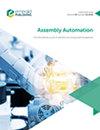Stability control for end effect of mobile manipulator in uneven terrain based on active disturbance rejection control
IF 1.7
4区 计算机科学
Q3 AUTOMATION & CONTROL SYSTEMS
引用次数: 3
Abstract
Purpose When the mobile manipulator is traveling on an unconstructed terrain, the external disturbance is generated. The load on the end of the mobile manipulator will be affected strictly by the disturbance. The purpose of this paper is to reject the disturbance and keep the end effector in a stable pose all the time, a control method is proposed for the onboard manipulator. Design/methodology/approach In this paper, the kinematics and dynamics models of the end pose stability control system for the tracked robot are built. Through the guidance of this model information, the control framework based on active disturbance rejection control (ADRC) is designed, which keeps the attitude of the end of the manipulator stable in the pitch, roll and yaw direction. Meanwhile, the control algorithm is operated with cloud computing because the research object, the rescue robot, aims to be lightweight and execute work with remote manipulation. Findings The challenging simulation experiments demonstrate that the methodology can achieve valid stability control performance in the challenging terrain road in terms of robustness and real-time. Originality/value This research facilitates the stable posture control of the end-effector of the mobile manipulator and maintains it in a suitable stable operating environment. The entire system can normally work even in dynamic disturbance scenarios and uncertain nonlinear modeling. Furthermore, an example is given to guide the parameter tuning of ADRC by using model information and estimate the unknown internal modeling uncertainty, which is difficult to be modeled or identified.基于自抗扰控制的不平坦地形移动机械臂末端效应稳定性控制
目的当移动机械手在未施工的地形上运行时,会产生外部扰动。移动机械手末端的载荷将受到扰动的严格影响。为了抑制扰动并使末端执行器始终保持稳定位姿,提出了一种机载机械手的控制方法。设计/方法/方法本文建立了履带机器人末端位姿稳定控制系统的运动学和动力学模型。通过该模型信息的指导,设计了基于自抗扰控制(ADRC)的控制框架,使机械手末端姿态在俯仰、横摇和偏航方向上保持稳定。同时,由于研究对象救援机器人的目标是轻量化和远程操作,因此控制算法采用云计算操作。结果具有挑战性的仿真实验表明,该方法在具有鲁棒性和实时性的复杂地形路面上能够取得有效的稳定控制性能。独创性/价值本研究有利于移动机械手末端执行器的稳定姿态控制,使其保持在合适的稳定工作环境中。整个系统即使在动态扰动和不确定非线性建模的情况下也能正常工作。最后给出了利用模型信息指导自抗扰控制器参数整定的实例,并对难以建模或辨识的未知内部建模不确定性进行了估计。
本文章由计算机程序翻译,如有差异,请以英文原文为准。
求助全文
约1分钟内获得全文
求助全文
来源期刊

Assembly Automation
工程技术-工程:制造
CiteScore
4.30
自引率
14.30%
发文量
51
审稿时长
3.3 months
期刊介绍:
Assembly Automation publishes peer reviewed research articles, technology reviews and specially commissioned case studies. Each issue includes high quality content covering all aspects of assembly technology and automation, and reflecting the most interesting and strategically important research and development activities from around the world. Because of this, readers can stay at the very forefront of industry developments.
All research articles undergo rigorous double-blind peer review, and the journal’s policy of not publishing work that has only been tested in simulation means that only the very best and most practical research articles are included. This ensures that the material that is published has real relevance and value for commercial manufacturing and research organizations.
 求助内容:
求助内容: 应助结果提醒方式:
应助结果提醒方式:


